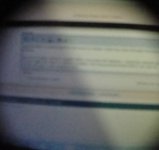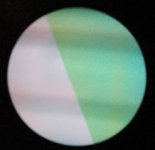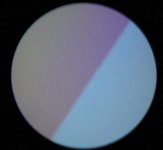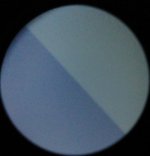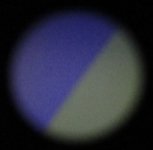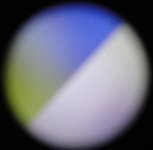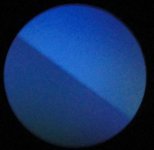John Russell
Well-known member
There was a recent discussion here:- http://www.birdforum.net/showthread.php?t=251175 on phase and mirror coatings, which prompted me to go back and investigate some of my bins.
One can check for phase coating by viewing a white TFT screen through the objective (i.e. backwards) and rotating a polarizing filter in front of the objective. In the absence of phase coating the two halves of the exit (now entry) pupil will alternately black out completely either side of the roof edge.
Phase-coated roof prisms will still usually allow one to detect the roof edge but the diiferences between the two sides are less pronounced. However, on two bins with dielectric coatings, a Swarovski SLC and a Kowa Genesis, I noted significant spurious colour differences either side of the roof edge. On a Meopta Meostar, which allegedly has silver-coated prisms, the roof edge was still faintly visible but when rotating the polarizing filter there was a continuous and uniform change from yellow to violet.
With my Swarovski ATM 65HD, which with its 45° Schmidt prism does not require any mirrored surfaces, the effect was similar except that due to the 30x magnification the yellows and violets were so intense that I was unable to see the roof edge.
It would appear that the multiple layers (often over thirty) of dielectric coatings cause arbitrary polarizations of different colours, which interact with the phase coatings on the roof surfaces. I have also often wondered about the lateral shift of different colours at a dielectric mirror surface although this is probably so small as to be invisible.
Dielectric coatings are today a "must have" for any bins with Schmidt-Pechan prisms but perhaps they are not without their disadvantages.
John
One can check for phase coating by viewing a white TFT screen through the objective (i.e. backwards) and rotating a polarizing filter in front of the objective. In the absence of phase coating the two halves of the exit (now entry) pupil will alternately black out completely either side of the roof edge.
Phase-coated roof prisms will still usually allow one to detect the roof edge but the diiferences between the two sides are less pronounced. However, on two bins with dielectric coatings, a Swarovski SLC and a Kowa Genesis, I noted significant spurious colour differences either side of the roof edge. On a Meopta Meostar, which allegedly has silver-coated prisms, the roof edge was still faintly visible but when rotating the polarizing filter there was a continuous and uniform change from yellow to violet.
With my Swarovski ATM 65HD, which with its 45° Schmidt prism does not require any mirrored surfaces, the effect was similar except that due to the 30x magnification the yellows and violets were so intense that I was unable to see the roof edge.
It would appear that the multiple layers (often over thirty) of dielectric coatings cause arbitrary polarizations of different colours, which interact with the phase coatings on the roof surfaces. I have also often wondered about the lateral shift of different colours at a dielectric mirror surface although this is probably so small as to be invisible.
Dielectric coatings are today a "must have" for any bins with Schmidt-Pechan prisms but perhaps they are not without their disadvantages.
John
Last edited:





